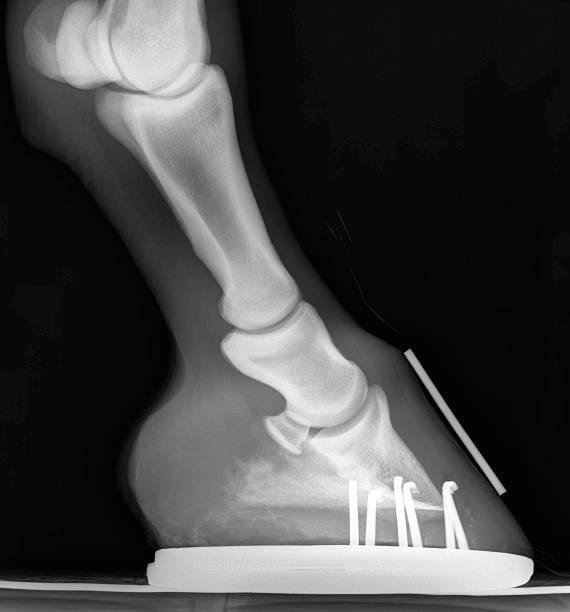Periosteal new bone formation on the dorsal, medial and lateral surfaces of the second phalanx are one manifestation of the condition known as phalangeal exoticism or ringbone in horses. Where these involve distal second and proximal third phalanxes it is called low ringbone and where proximal second and distal first phalanxes, high ringbone. Depending on whether the inner phalanx joints are involved or not the ringbone in horses may be articular or non-articular. Articular ringbone is death within the subsection on arthrology.
The Etiology of the Ringbone or Sidebone in Horses

Non-articular (Periarticular) ringbone affects front and hind limbs equally. The periostitis is triggered by tearing of fibers of soft tissue attachments, example common digital extensor tendon or collateral ligaments or by direct external trauma. Depending on the time and nature of the insult, cases may present with acute or chronic lameness. Wire and tear from the repeated concussion ( vibration) of the pastern example during road work.
Clinical Signs of Ringbone In Equine
 In acute cases, sudden onset, moderate to severe lameness developed. There is increased digital pulse amplitude and often a decreased area around the pastern which is sensitive to pressure. The absence of solar pain is a useful aid for locating the site of pain. In chronic cases, lameness is usually low grade and may be gradually progressive. If considerable exotosis has developed this will be palpable.
In acute cases, sudden onset, moderate to severe lameness developed. There is increased digital pulse amplitude and often a decreased area around the pastern which is sensitive to pressure. The absence of solar pain is a useful aid for locating the site of pain. In chronic cases, lameness is usually low grade and may be gradually progressive. If considerable exotosis has developed this will be palpable.
The most common signs of Ringbone in horses are:
- Pain
- Lameness
- Heat
- Tenderness
- Swelling
Diagnosis of Sidebone in Horses
At first, you will notice the signs of the disease condition in your horse that tends to be moderate lameness, tenderness, and the heat radiating from the area.
Palmer or planter perineural analgesia alleviate lameness at abaxial sesamoid level. Some cases may also improve to Palmer or planter digital nerve block. Intraarticular analgesia (of P1/P2 and P2/P3 joints) can differentiate articular and non-articular cases.

Radiography is necessary for diagnosis, and periosteal new bone should be assessed for signs of activity. In acute cases may not show radiological changes for 3 to 4 weeks following injury. In more advanced diagnostic measure, Magnetic Resonance Imaging(MRI) may help to detect ligament and cartilage abnormalities.
Treatment Strategy of Ringbone in Horses
 In non-articular cases, rest is the only appropriate therapy for your horses. Immobilization of the lower limb is advisable even to the point of casting early examples. Box confinement in necessary for four weeks followed by a further ⅔ month of controlled exercise depending on the age and activity of the lesion.
In non-articular cases, rest is the only appropriate therapy for your horses. Immobilization of the lower limb is advisable even to the point of casting early examples. Box confinement in necessary for four weeks followed by a further ⅔ month of controlled exercise depending on the age and activity of the lesion.
- The prognosis for the non-articular cases is generally favorable.
- Corrective shoeing is also very helpful to reduce the signs of ringbone in horses.
- An anti-inflammatory medication also helps your horse during pain.
- Oral medication or intra-articular medication can be used when your horse needs.
- In more advanced cases, you can go for surgical intervention but most of the cases it will be detrimental for horses.
Can Ringbone in Horses Cure?
In proper treatment and care, ringbone may be cured. However, this requires a long time and extra patience of horse owner. Calcium supplement in the horse diet also sometimes helps to reduce the condition.
Is Ringbone in a Horse is Genetic?
Ringbone is not horse breed specific but articular or “True” ringbone is genetic. In high ringbone, pastern joint is affected, and in Low Ringbone, coffin joint is affected. Within these two conditions, high ringbone is more common.
Final Advice on Sidebone in Horse
Ringbone is a disease that attacks both young and older horses. It is a joint disease that causes the horse is lame. If your horse does develop in sidebone, it is important to have his hooves trimmed and shoed regularly. You have to maintain a healthy weight and give your horse plenty of rest when needed and it is important to his healing process. In my writing, I have to discuss all information of ringbone which is very essential to know the horse lover.